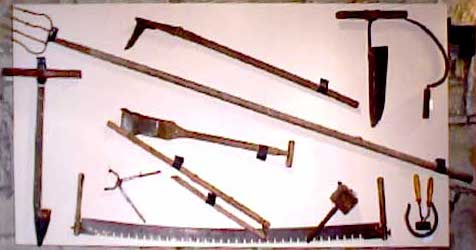Farming Implements
Clockwise from the bottom
-
Cross-cut saw
-
Stiabhinn
-
Breast Slane
-
Hay knife
-
Sickle
-
Pony Clippers
-
Horse-shoe
-
Mallet
-
Flail
-
Slane
-
Drag
- Curry Comb
Irish Title
-
Sabh
-
Stiabhinn
-
Slean
-
Scian Feir
-
Corrainn
-
Bearathoir Caipini
-
Cru Capaill
-
Maillead
-
n/a
-
Slean
-
Dreag
- Cior
Brief Description
-
Long, serrated, steel saw, with wooden handles, 12" high, on either end. Total length, 68"
-
Iron tipped implement, 34" long, with wooden handle: 18" wide.
-
Iron implement with cutting edge and wing set at right angles, fitted with a wooden handle on top. Overall length, 30", with wing measuring 4"
-
22" long wooden handle with steel shaft.
-
Hooked, steel implement with wooden handle, 20" long
-
Small, tongs-like implement, with wooden handle, measuring 11" long.
-
Iron implement, 71/2" x 7," attached through nails into grooves in horse-shoe and 'clenched' from thatinto horse's hoof.
-
All-timber block with handle through it, roughly hammer-shaped, measuring 9"
-
Hand-threshing implement, wooden staff at end of which a short, heavy stick hangs swinging, used for threshing oats and corn. Total length, 64"
-
Iron implement with cutting edge and wooden shaft and straight, rounded handle called 'fasc.' Length, 46"
-
Iron, fork-shaped implement with outer thongs of approx 4", attached to long wooden handle. Total length, 108"
- Pincers-like implement, 12" long.
Function / Use
-
Used for felling trees
-
Used to make hole in the soil into which potato was set. Dropping the slit potato into the hole was known as 'goggaring' and covering the hole as 'quenching.' This was the normal way to set potatoes prior to the invention of the tractor. Approximately 80 years old.
-
Used for horizontal cutting of turf, as opposed to underfoot cutting.
-
Used for cutting hay up to the 1950s.
-
Implement used to cut corn or grass, prior to the invention of the scythe.
-
Used to clip pony's tail
-
The horse-shoe functioned to protect the horse's hoof. It was also thought to be a 'good luck' omen.
-
Used in carpentry and also by coopers to secure bungs on top of barrel.
-
Used for the vertical cutting of turf bank
-
Probably improvised implement used for draining river and river banks. Originally, probably a form to which a specially made handle was attached to enable it reach across and down drains.
- Used to comb or groom the mane of ponies and horses.
Find Details / Provenance
-
Used by Kelly family, Kiltimagh
-
In use by the Glynn family, Kiltimagh, up to the 1950s
-
Used by the Kelly family at their bog in Kilcon until 1950s.
-
In use by the Walsh family in Cullilea, Kiltimagh.
-
Used by the Brennan family, Kiltimagh
-
Used by the Walsh family, Kiltimagh
-
Used by the Fannon family in their family farm.
-
Used by the Cooper Farrell, Kiltimagh
-
Used by the McNicholas family, Kiltimagh
-
Used by the McNicholas family on their bog at Kilcon, up to the 1950s.
-
Used by the Kelly family, Kiltimagh
- Used by McNicholas family, Craggagh.

Kiltimagh Railway Museum
Kiltimagh
County Mayo
+ 353 (0)86 101 1388
solanb@gofree.indigo.ie
Sneak Peek
Some interesting items can be viewed here
- Abacus Ball-frame
- Apron
- Barber's Pole and Chair
- Bedspread or Quilt
- Bicycle Permit
- Clay Pipe
- Copying Press
- Cosmetics
- Doll
- Farming Implements
- Gas Lamp
- Gas Meter
- Gold medal
- Life Jacket
- Model Locomotive
- Locked draws
- Glass Case
- Olympic Crest 1924
- Police hat and badge
- Pottery Hot Water Bottle
- Ration Book
- Replicas of Boston Famine Memorial
- Scales
- Scales for eggs
- School Clock
- Sculpture of the Station Master
- Sketch of Raftery
- Staff Key
- Sundial
- Sword
- Wooden Trap
- Wooden Cradle